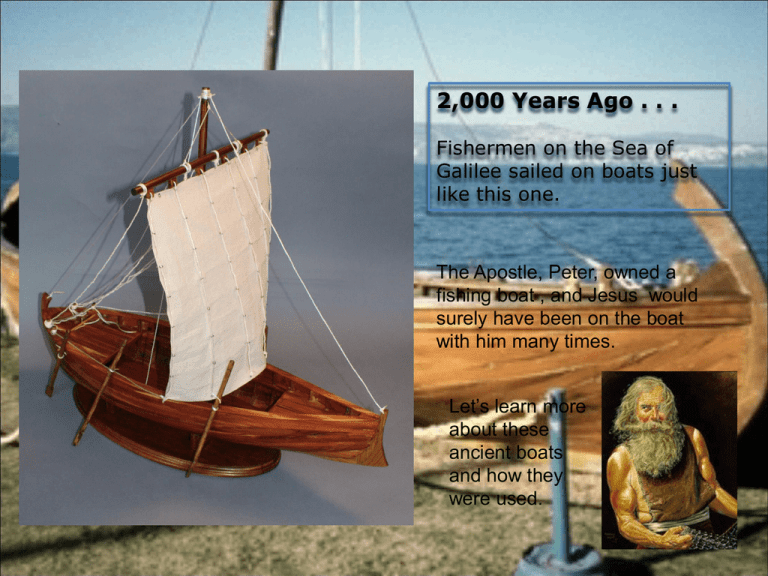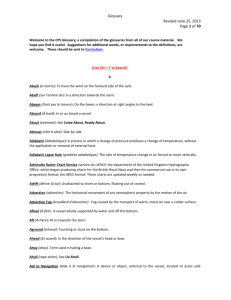Galilee Boat Slide Show - Sea of Galilee Boat Model
advertisement

2,000 Years Ago . . . Fishermen on the Sea of Galilee sailed on boats just like this one. The Apostle, Peter, owned a fishing boat , and Jesus would surely have been on the boat with him many times. Let’s learn more about these ancient boats and how they were used. A 2,000 Year-Old Galilee Fishing Boat In 1986 a sunken boat was found near the northwest shore of the Sea of Galilee. A marine archaeologist from Texas A & M carbon dated it between 100 BC and 70 AD. This places the boat at the time of Jesus. Archaeologists have determined this is the same type of boat used by hundreds of fishermen on the Sea of Galilee. Research about this boat has brought new insight into many New Testament stories and events that took place on and around the Sea of Galilee. Above: Area around Sea of Galilee Left: Map of Palestine When Jesus was chased from his home village of Nazareth, he went to the Sea of Galilee and lived with Peter and Peter’s mother-in-law in Capernaum. Here are ancient remains of a house some believe to have belonged to Peter and his mother-in-law in Capernaum. Peter was a fisherman, and owned a boat that must have been similar to the one recovered near Magdala in 1986. These boats needed five men to man the boat and to fish – four to row and one helmsman. Sails could only be used going downwind. They must be rowed into the wind. Let’s Build a Model of the Sea of Galilee Boat by Dick Webber© The ancient boat was built with oak keel and frames (ribs) and cedar planks for the hull. It was about 27 feet long and 9 feet wide Matthew 13:47-48 reads “Again, the kingdom of heaven is like a seine net which was thrown into the sea and gathered fish of every kind; when it was full, men drew it ashore and sat down, and sorted the good into vessels but threw away the bad.” 1:10 Scale model of Sea of Galilee boat It had a single mast with a square sail, and a large deck at the stern to hold the heavy seine net used for fishing. A model approximately one-tenth (1:10) the size of the original was constructed, following the drawings made by Dr. Shelley Wachsmann and Dr. Richard Steffy of Texas A & M. More than 50 references occur in the New Testament about events and stories involving the Sea of Galilee. Building a True Replica The original boat was made with oak keel and frames, and cedar planking. I used these materials for the model. The shapes of the frames (ribs) and keel were determined from drawings made by Professor Richard Steffy of Texas A & M. Patterns made from these drawings were used to cut each frame and the keel. The frames were dowelled into the keel, then the cedar planks were steamed for bending. After being clamped in place overnight, each plank was glued in place to form the hull. Oars: Four oars, two on each side. Oars and rudder were turned on a lathe to be 10 inches long and .35 inches in diameter, and the blades shaped by carving and sanding. Oars are lashed to thole pins on the gunnels. Steering: Quarter rudders on each side of the boat were used to steer. Sail, Rigging, Decks and Ceiling: The excavation of the boat did not reveal the sizes or types of mast, sail and rigging. Professors Steffy and Wachsmann relied on their knowledge of other ancient boats of the period to conclude it was a brailled rig sail, square or rectangular in shape. Evidence of a single mast step was found slightly forward of amidship, fastened to the keel. The boat accommodated four oarsmen and a helmsman who used quarter rudders for steering. They believe there were decks at the bow and stern that together covered about 40% of the length of the boat. “Ceilings” of planks served as footboards, lying on top of the frames. 1/2 inch below the top of the mast I cut a 1/8 inch wide by 5/8 inch tall through mortise, and a pulley 1/2 inch in diameter to fit inside the mortise. The pulley turns on a brad for a shaft. This receives the halyard to raise and lower the yard. A cleat at the foot of the mast ties off the halyard. People of the Period The average man between the Hellenistic and Byzantine period was estimated to be 5’ 5” tall. A simple tunic was the customary garment. Wood figures 14 cm. high for the men that match the scale of the boat were found at www.MadisonArtShop.com. Tunics of the period would have been made of either linen or wool (from sheep or camels). Tunics for these figures were made of greige colored linen/cotton. Jesus chose four of his disciples from among the fishermen at Capernaum. These paintings are by Kenneth Wyatt as he imagined they might look. Kenneth Wyatt is a Methodist pastor who has become a noted artist. These paintings are displayed at the Methodist Museum at St. Simons Island.. Andrew James Jesus Peter was a fisherman who owned his own boat. Simon Peter Other Kenneth Wyatt Paintings of the Apostles and John Kenneth Wyatt saw these men as strong, out-door, hard-working, men of action and resolve. John Thomas James the Less Philip Bartholomew Jude Matthew Judas Jesus Calms the Storm Rembrandt 35That day when evening came, he said to his disciples, "Let us go over to the other side." 36Leaving the crowd behind, they took him along, just as he was, in the boat. There were also other boats with him. 37A furious squall came up, and the waves broke over the boat, so that it was nearly swamped. 38Jesus was in the stern, sleeping on a cushion. The disciples woke him and said to him, "Teacher, don't you care if we drown?" 39He got up, rebuked the wind and said to the waves, "Quiet! Be still!" Then the wind died down and it was completely calm. 40He said to his disciples, "Why are you so afraid? Do you still have no faith?" 41They were terrified and asked each other, "Who is this? Even the wind and the waves obey him!“ - Mark 4:35-41 NIV Stern View This shows the deck for the large seine net, and the braille-rigged sail. The sail is raised by hauling in the six braille lines. When not travelling with the wind, the boat is rowed by four oarsmen. Steered by quarter-rudders. The flat bottom allowed it to float in shallow water, and be easily brought to shore. 1:10 scale model built by Dick Webber, following description provided by Professors Shelley Wachsmann and Richard Steffy of the Biblical Archaeology department in the Nautical Archaeology Program at Texas A&M University – it is thought to be one of only two or three authentic models built of this ancient boat.







